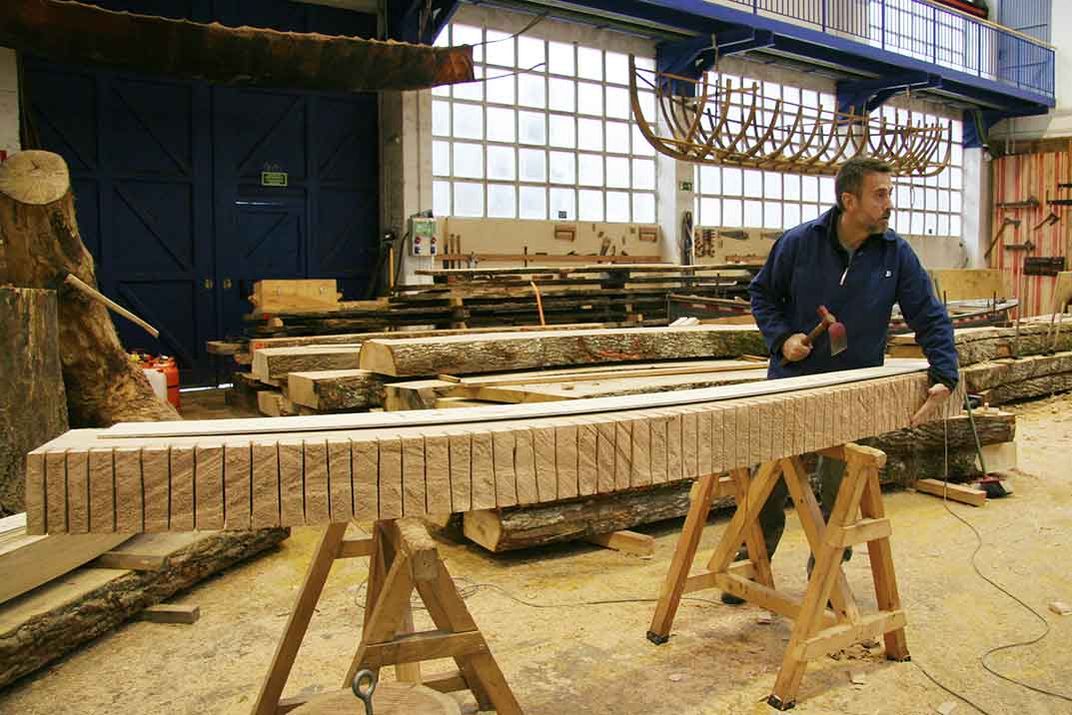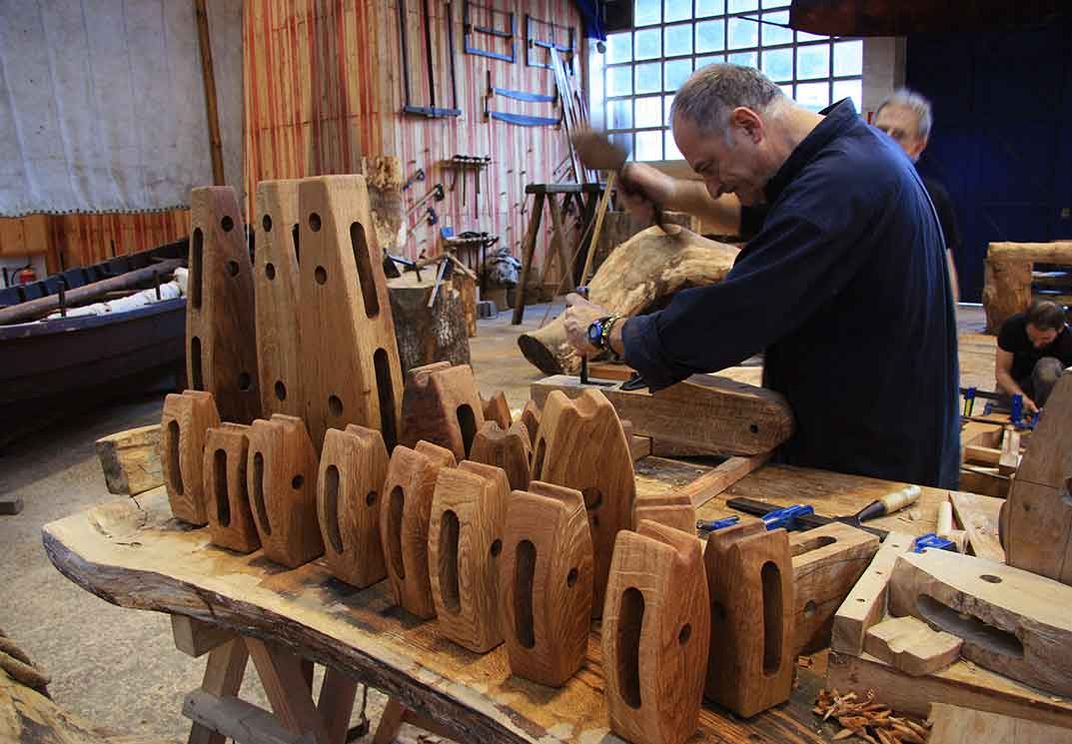There’s a Lot More to This Basque Boat Than Meets the Eye
The lost story of the Basque heritage is just waiting to be discovered and could be revealed just by watching craftsmen rebuild an ancient whaler
/https://tf-cmsv2-smithsonianmag-media.s3.amazonaws.com/filer/4f/c7/4fc7dccf-9d81-40b4-8b00-6b71e423cb71/sff2016jw6220019web.jpg)
In 1978, Canadian archeologists discovered the remains of the San Juan, a Basque transoceanic vessel used to carry whale oil from Red Bay in Labrador, Canada back to Basque Country. With the San Juan, the archeologists also found a txalupa, a small swift boat used to chase and harpoon whales. The Albaola Sea Factory, a traditional shipbuilding workshop in Pasaia San Pedro, is currently rebuilding the San Juan, using 30 years of meticulous records kept by the archeologists at Red Bay, with techniques dating to the 16th century when the San Juan wrecked and funds from UNESCO.
“[The archeologists] were very thrilled by the possibility of seeing in reality what they saw only as a shipwreck,” explains Mikel Leoz, a member of Albaola in charge of the volunteers who work on the recreations along with skilled shipbuilders.
“We think here in Albaola that the maritime identity of the Basques have been neglected for too long,” he says. The San Juan project’s expected complete date is sometime in 2020, after which the boat will become a part of the Albaola museum.
Leoz, along with two other shipbuilders, Markos Sistiaga and Ernesto Fernandez, arrived in Washington, D.C. in June with a 26 foot-long skeleton, oak timber and other traditional materials shipped from Basque Country and set up shop on the National Mall to build a ship at the Smithsonian’s Folklife Festival, now on view through July 4 and July 7 to July 10.

When the Smithsonian Center for Folklife and Cultural Heritage began their process to determine the program for this year’s Festival, the Basques kept coming up. “This idea of the Basques being very modern and having a very modern way of looking at the world came up again and again,” says Cristina Diaz-Carrera, one of the two curators of this year’s program “Basque: Innovation by Culture.”
Basque marine scientists, for example, were the first to set standards for sustainable fishing and now help determine the yearly fishing regulations for the European Union.
“But of course they also have deep connections to their roots,” says Diaz-Carrera, “so the idea behind the title ‘Innovation by Culture’ was to try and capture that idea.”
Diaz-Carrera says the hope was to recuperate “lost knowledge that was never written down.”
Highly doubtful myths suggest that the Basque, who still reside in their ancestral homeland in the western Pyrenees, descend from Cro-Magnon hunters or from the lost 13th tribe of Israel. But the Basque do represent one of oldest living cultures in Europe, their language predates the Indo-European invasion of Iberia around 900 B.C. And since the 9th century, the Basque have maintained a thriving maritime economy, sailing far beyond the Bay of Biscay to hunt whales and later cod in the North Atlantic.

They used the abundant oak trees and iron ore available to become leaders in the European shipbuilding industry, developing technology that ranged from small fast whale-hunting boats to trans-Atlantic capable ships.
Bill Fitzhugh, director of the Smithsonian's Arctic Studies Center at the National Museum of Natural History, estimates that they reached the New World only a decade or so after Columbus, whose 1492 boat was built by Basque craftsmen.
“The Basque are probably the least known part of American history,” Fitzhugh says, who studies North American outposts where the Basque fisherman interacted with 17th-century Inuit hunters in New Foundland.
“The Basque were the first people to industrialize resources from the Americas, whale oil primarily,” he says. “Later on they were leaders in the cod fishing industry well before the Europeans got involved.”
But the Basque left few footprints. Instead of exerting a colonizing effort like the English in Newfoundland or the French in Nova Scotia, the Basque would always return to Europe at the end of the whaling or fishing season, planting no flags to indicate that they had been there.
“Its really a story of an entrepreneurial population that saw opportunities, developed the techniques they needed to do it and did this for a while until the situation changed,” says Fitzhugh.
The climate changed, the whales declined and with more competition from larger societies like the Dutch and English, the Basques turned their business ventures elsewhere. Without a community left behind to record their story, their maritime legacy within the Americas and the prowess they demonstrated for centuries is often overshadowed by the nations that left resident populations.
And so the port, or portua, becomes the both the start and endpoint of the Basque maritime economy and Festival organizers wanted to recreate that gateway to convey the culture’s seafaring heritage—its cooking, its sport and all of the industry of boat builders and net menders and agriculturalists and craft that sprang up in the port to support the sailors as they ventured out and then returned home.
Folklife Festival attendees will be able watch and ask questions of the Albaola Sea Factory shipbuilders while they craft a txalupa from oak timber and other traditional materials shipped from Basque Country. Albaola has already rebuilt and sailed with two other txalupas using what they affectionately call the mother whaleboat from the San Juan wreck as a reference.
They finished the first replica in 2005 and the second in 2006 after about a year’s worth of work on each although Leoz says they could do it much faster.
The rebuilding process for the festival will include wooden planks carved from the oak, traditional iron ore nails and tar to seal up the boat and no electronic technology. Although the boat might not be finished by the end of the festival, Diaz-Carrera emphasizes that demonstrating the traditional techniques and the mission of Albaola is the primary goal.
“We could publish endless books with that information and some people would get the message and some people wouldn’t,” Leoz says. “But when you are building a ship, something that in itself is beautiful, it’s suggestive and very attractive and it’s much more powerful than any other means.”
The Folklife Festival on the National Mall in Washington, D.C. takes place June 29 to July 4 and July 7 to July 9, 2016.